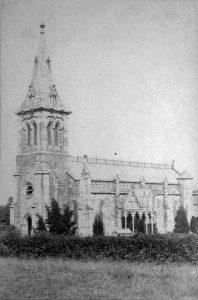 Kilndown Parish Church, dedicated to Christ, is sited in the centre of this small thriving village. It was originally built as a chapel to the Parish Church of St Mary’s, Goudhurst, two miles away
Kilndown Parish Church, dedicated to Christ, is sited in the centre of this small thriving village. It was originally built as a chapel to the Parish Church of St Mary’s, Goudhurst, two miles away
In the mid-1830s a Committee, which included Viscount Beresford of Bedgebury together with several other local landowners, met to plan a more convenient place for worship for the residents of Kilndown. This was followed in 1838 by a meeting between the curate of St Mary’s and the Archbishop of Canterbury to discuss it further.
When enough money had been raised, building work started using stone dug from a quarry across the road and employing the labourers who had been working on the substantial re-building at Bedgebury Mansion. The foundation stone was laid in September 1839 by Louisa, Viscountess Beresford.
The architect hired for the new Church was Anthony Salvin a well-established Victorian architect and an expert on medieval buildings, who produced a serviceable but plain design. Louisa’s son Alexander had a very different idea on how the Church should look and came onto the planning committee. As a member of the Cambridge Camden Society, later known as the Ecclesiological Society, he proceeded to enhance the original design according to this organisation’s ethos, funding it himself.
These innovations were daring for the period particularly the richly carved stone altar, which replaced a table. The pulpit painted red, gold and blue was modelled on one in Beaulieu Abbey. No expense was spared for the brass eagle lectern and two crowns that held tapers, designed by William Butterfield. Although now gone, there were texts painted around the walls and the ceiling was transformed to represent the Vault of Heaven.
An Italian architect called Alexander Roos created a richly carved oak screen. The timber for the Church came from the Bedgebury estate and much of the carving was done by local carpenters. The gilded rood-screen, the coloured walls, the lustre on all fittings and the universal stained glass was acclaimed by The Ecclesiologist as ‘a whole of colour such is to be seen in no other English church at the present time’. The stained glass windows commissioned from the Royal Bavarian factory in Munich were created by Franz Eggert.
The stone reredos above the altar is a memorial to the Beresfords with each religious figure representing a member of the family. The quality of Christ Church ornamentation was described in 1954 when a building survey was ordered. Comments such as ‘it should be looked upon by the Diocese and County as a priceless period piece’ were made and ‘it contains some of the best Gothic Revival work and stone carving that I have ever seen’. However, these came amid concerns about serious damp penetration into the porous stone walls.
For a longer history click here
Parish Registers
The parish registers date from 1843 and were transcribed during the 1930s. The society has copies of the transcripts as follows: –
Baptisms – 1843 – 1915
Marriages – 1843 – 1930
Burials – 1843 – 1945
